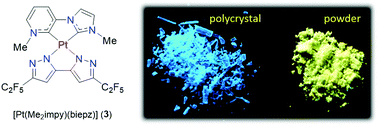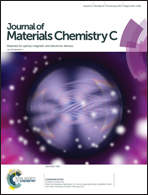Luminescent Pt(ii) complexes featuring imidazolylidene–pyridylidene and dianionic bipyrazolate: from fundamentals to OLED fabrications†
Abstract
Pt(II) complexes bearing imidazolylidene–pyridylidene (impy) and dianionic biazolate chelates were synthesized, for which the end products depend on the alkyl substituents of the impy chelate. Treatment of Pt(DMSO)2Cl2 with dimethyl substituted imidazolium–pyridinium pro-ligand Me2impy(PF6)2, followed by addition of 5,5′-(1-methylethylidene)-bis-(3-trifluoromethyl-1H-pyrazole) (mepzH2), 5,5′-di(trifluoromethyl)-3,3′-bis-pyrazole (bipzH2), and 5,5′-di(pentafluoroethyl)-3,3′-bis-pyrazole (biepzH2), afforded Pt(II) complexes [Pt(Me2impy)(mepz)] (1), [Pt(Me2impy)(bipz)] (2) and [Pt(Me2impy)(biepz)] (3), respectively. In contrast, reactions with ethyl and isopropyl substituted Et2impy(PF6)2 and Pr2impy(PF6)2 and with bipzH2 gave [Pt(EtimHpy)(bipz)] (4) and [Pt(PrimHpy)(bipz)] (5) respectively, where notable alkyl-to-hydrogen transformations on the pyridylidene fragment took place. The reaction of Pt(DMSO)2Cl2 with Et2impy(PF6)2 followed by addition of (biepzH2) gave two products [Pt(Et2impy)(biepz)] (6) and [Pt(EtimHpy)(biepz)] (7). Single crystal X-ray diffraction analyses of 1, 2 and 5 revealed negligible intermolecular Pt⋯Pt interactions. Hybrid-DFT and TD-DFT computations were carried out on 1, 2 and 5 to model the observed crystal structures and explain the photophysical data successfully. Organic light emitting diodes (OLEDs) were fabricated from complexes 4 or 5 using a multiple layered device architecture. The associated OLED performances (i.e. ηmax = 12.5%, 11.2%, ηL = 44.0 cd A−1, 40.6 cd A−1, and ηP = 28.0 lm W−1, 25.8 lm W−1 for 4 and 5) confirmed their suitability in serving as potential OLED phosphors.



 Please wait while we load your content...
Please wait while we load your content...